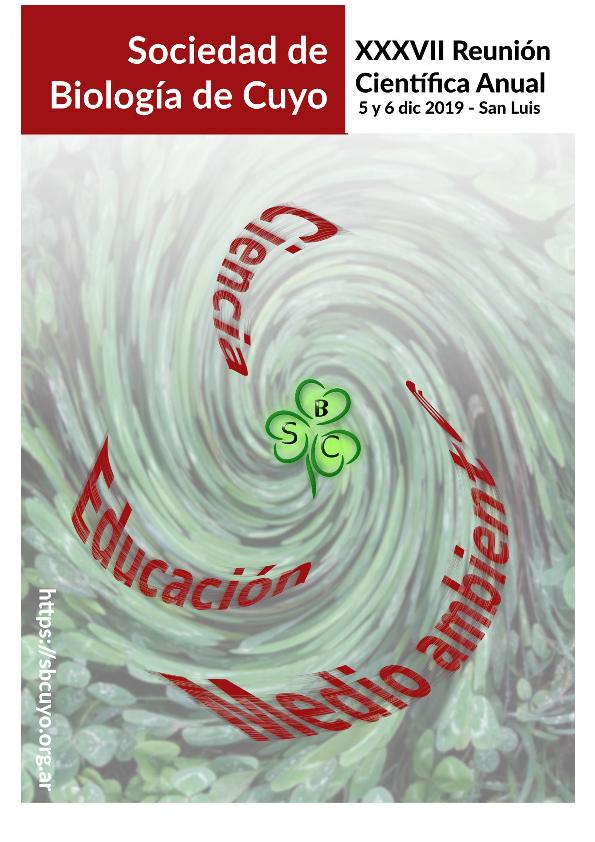Evento
Differential expression and localization of beta-catenin and HSP27 after cisplatin/doxorubicin treatment in triple negative breast cancer cells
Córdoba, María Evelyn ; Pennacchio, Gisela Erika
; Pennacchio, Gisela Erika ; Cayado Gutiérrez, Niubys de Los Milagros
; Cayado Gutiérrez, Niubys de Los Milagros ; Cuello Carrión, Fernando Darío
; Cuello Carrión, Fernando Darío ; Nadin, Silvina Beatriz
; Nadin, Silvina Beatriz ; Vargas Roig, María Laura; Fanelli, Mariel Andrea
; Vargas Roig, María Laura; Fanelli, Mariel Andrea
 ; Pennacchio, Gisela Erika
; Pennacchio, Gisela Erika ; Cayado Gutiérrez, Niubys de Los Milagros
; Cayado Gutiérrez, Niubys de Los Milagros ; Cuello Carrión, Fernando Darío
; Cuello Carrión, Fernando Darío ; Nadin, Silvina Beatriz
; Nadin, Silvina Beatriz ; Vargas Roig, María Laura; Fanelli, Mariel Andrea
; Vargas Roig, María Laura; Fanelli, Mariel Andrea
Tipo del evento:
Congreso
Nombre del evento:
XXXVII Reunión Científica Anual de la Sociedad de Biología de Cuyo
Fecha del evento:
05/12/2019
Institución Organizadora:
Sociedad de Biología de Cuyo;
Título del Libro:
Libro de resúmenes de la XXXVII Reunión Científica Anual Sociedad de Biología de Cuyo
Editorial:
Sociedad de Biología de Cuyo
Idioma:
Inglés
Clasificación temática:
Resumen
The treatment of triple-negative breast cancers involves the administration of the conventional chemotherapeutic drug doxorubicin, given the lack of specific targeted agents. Novel therapeutic strategies, such as cisplatin, are currently being tested for these patients. Many studies have demonstrated that aberrant Wnt/β-catenin signaling serves a role in the development of breast cancer, while others have concluded that abnormal regulation of Wnt pathway induces tumor cell chemoresistance. The small heat shock protein 27 (HSP27) is overexpressed in human breast cancer cells. As a result, cancer cells may suppress apoptosis and develop resistance to antineoplastic agents, such as doxorubicin. The present study sought to examine the role of the Wnt/β-catenin and HSP27 signaling pathway in response to cisplatin (CisPt)/doxorubicin (Doxo) treatment in human triple-negative (TN) breast cancer cell lines. Material and Methods: MDA-MB231 (TN) and MCF10A cell lines were used. Cell viability was measured using MTT assay and IC50 values were obtained after 48 h of CisPt or Doxo exposition. β-catenin and Hsp27 gene expression were measured by qPCR. Total and active β-catenin, phosphor ant total HSP27, phospho and GSK3β, phosphor and total p38 expressions were measured by western blot and immunofluorescence. 3D cell culture from MDA MB231 cells were treated with increasing concentrations of CisPt and Doxo for 48h. Results: MDA-MB231 cells showed higher IC50 values for CisPt and Doxo than the MCF10A cell line. In MDA-MB231 cells, the expression of β-catenin, active β-catenin, total and phospho-GSK3β and total HSP27 significantly decreased in the CisPt group (p<0.05). No changes were observed in Doxo-treated group. In MCF10A cells, the expression levels of total and active β-catenin did not modify with CisPt treatment, but in the Doxo group the proteins evaluated showed a tendency to increase. Also in MCF10A Doxo treatment significantly decreased the expression of GSK3β in comparison with control (p<0.05). In contrast, CisPt administration significantly increased phospho-GSK3β expression respect to the control group (p<0.05). Interestingly, in MDA-MB231 cells the nucleolus appeared disaggregated and active β-catenin increased at this subcellular localization after CisPt and Doxo treatment. In contrast, total β-catenin was preferentially localized in the Golgi. In the other hand 3D cell culture was more resistant to Doxo-treatment than 2D cell culture. CisPt induced a decrease in 3D cell culture growth. Conclusions: CisPt treatment was associated with decreased expression of β-catenin and HSP27. While in Doxo-treated cells, as related to stable levels of β-catenin and increased expression of HSP27. The differential expression and localizations of β-catenin and HSP27 could be related to a differential cellular response depending on the cytotoxicity mechanism of chemotherapeutic agent used., that in turns affect the cell fate decision. Our preliminary data indicate that β-catenin and HSP27 may be potential therapeutic targets in TNBC.
Palabras clave:
CANCER DE MAMA
,
CISPLATINO
,
DOXORRUBICINA
,
TRIPLE NEGATIVO
Archivos asociados
Licencia
Identificadores
Colecciones
Eventos(IMBECU)
Eventos de INST. DE MEDICINA Y BIO. EXP. DE CUYO
Eventos de INST. DE MEDICINA Y BIO. EXP. DE CUYO
Citación
Differential expression and localization of beta-catenin and HSP27 after cisplatin/doxorubicin treatment in triple negative breast cancer cells; XXXVII Reunión Científica Anual de la Sociedad de Biología de Cuyo; San Luis; Argentina; 2019; 15-16
Compartir



